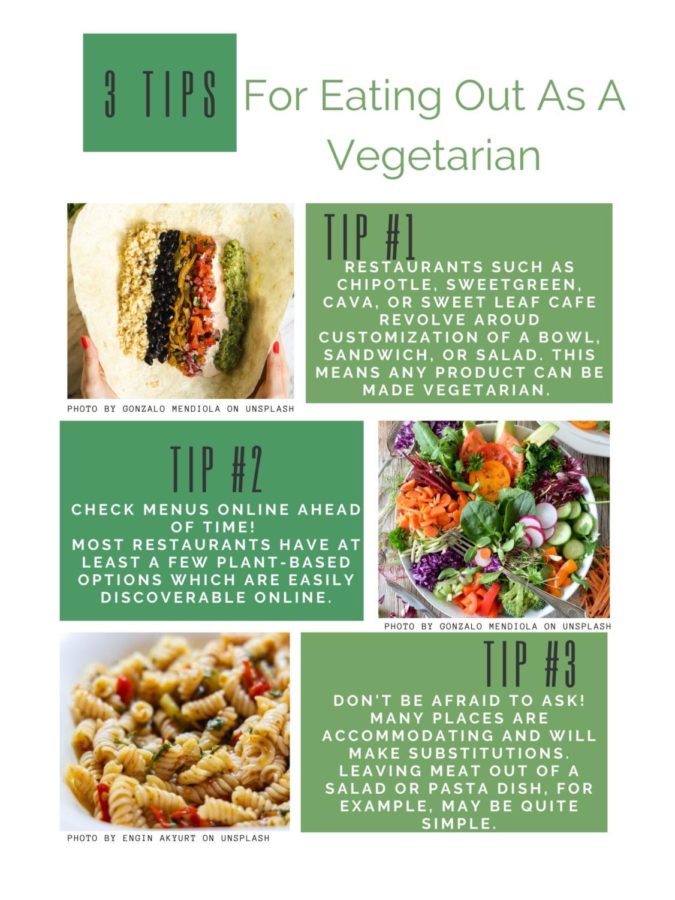The ins and outs of vegetarianism
Navigating a plant-based lifestyle in Arlington
Arlington Tech sophomore and member of the school’s track team, Cheyenne Klapper, sits at Busboys and Poets in Shirlington. Around her, what look to be hamburgers, cheesy nachos and chicken stir fry are delivered to various tables. Despite their appearance, these meals are all completely plant based. The burger is made with a black bean patty, vegan cheese and sour cream top the nachos and the chicken is made of soy. While the restaurant offers many options for meat and dairy lovers as well, Busboys and Poets is one example of a restaurant striving to accommodate a growing vegetarian and vegan population.
“I feel like more and more there’s going to be more options available [for vegetarians],” senior and vegetarian Lila Carruthers said. “Places like South Block or chains that are more geared towards people that are vegetarian or vegan…they’re just popping up more and more.”
There are a variety of reasons that one becomes vegetarian or vegan, and these reasons can change over time. Klapper first became pescatarian, meaning the only meat product she consumed was fish, after learning about the health benefits of a Mediterranean diet. Over time her greater motivation became environmental sustenance and animal rights, ultimately leading to her choice of full veganism, which means she no longer eats any type of animal product, including things like dairy or honey.
“It started to transition towards being vegan for animal rights and environmental rights because I was researching about that and watching documentaries about that,” Klapper said. “I used to be a very big meat eater. But all of a sudden something clicked in my head that it was wrong for me as a person. It was morally wrong and I could not do that anymore because I feel like these animals are being abused, tortured and stuff and it just didn’t sit right with me.”
When it comes to the environment there are multiple issues caused by meat-inclusive diets; mainly, methane and greenhouse gas emissions as well as water usage. The beef and cattle industry is seen as one of the main contributors to greenhouse gas emissions as cows generate methane through waste and digestion. In terms of water usage, it is said that one pound of beef takes about 1,800 gallons of water to produce, much more than for producing most vegetables and plant-based foods.
“I’m really interested in environmental science and [for] my major I want to do wildlife conservation,” senior and vegetarian Mary Superata said. “Not only do [the side effects of eating meat] affect me but [also] the people around me.”
While there are benefits to a plant-based diet, not eating meat products can also cause complications for students. When cutting out meat, one must still ensure they are getting protein, iron, and other necessary nutrients. As a general rule, Klapper looks to ensure that all of her meals include a carbohydrate, a vegetable and protein.
“I have lots of little meals that I make,” Klapper said. “Something that’s very quick and easy that gets all your nutrients in is I take a can of black beans and put taco seasoning in with olive oil and I just fry that up. Then I get some tortillas and I put them in the oven with some olive oil so they’re more like chips but they’re kind of soft. Then I just eat that with cucumbers… I have that literally all the time and it takes like ten minutes.”
Carruthers utilizes meal prep.This way, she has different foods that fit what she likes to eat and can be added into meals throughout the week. Prepping meals ahead of time may be beneficial for those with busy schedules.
“On the weekends [my mom and I] make bigger meals or we’ll roast a bunch of vegetables to have for the week,” Carruthers said.
When looking to become vegetarian or vegan, one does not necessarily need to change their entire diet.
“Go with stuff that’s familiar to you, that you enjoy,” Superata said. “If you really like lasagna with meat in it, just sub out the meat [to make it vegetarian]. You can still have your favorite foods, just try to make it meatless.”
Going fully vegetarian or vegan can be a big step, and many are not in a position to do so. For those still looking to support the cause, Superata recommended small steps such as meatless Mondays and Tuesdays or eating meatless when at restaurants. Finding plant-based foods that one enjoys and can easily have on hand is also important, for Carruthers that item is bagels with vegan cream cheese.
“I just want to encourage anybody to eat more plant based in general, you don’t have to be vegan, I just wish people would eat more plant based, mostly for environmental reasons,” Klapper said. “If anybody’s like ‘oh, I’m thinking about it,’ I’ll try and help them as much as I possibly can.”
Restaurants:
Most restaurants in Arlington have at least one to two vegetarian or vegan options. But knowing which ones are most accessible and have the most extensive plant-based menus, as well as how to manage restaurants with fewer meatless options, is important in being successful as a vegetarian.
“We live in a nice area where it’s pretty diverse in the food [choice] that they have,” Superata said. “But I know when I go to the beach with my family we go to seafood restaurants and so it’s definitely harder to find things but there’s usually ways you can get around it. [For example], if you get pasta without the meat in the sauce…just little things that usually work out.”
Nearby, True Food offers many plant-based options, interspersed in the menu among meat options. These include vegan double cheeseburgers and pizza as well as other salads and bowls. All of the dessert options accommodate vegetarians and most, including ice cream, are vegan. However, the restaurant is on the more expensive side.
“I really like Chipotle because it’s really filling and not too expensive,” Carruthers said. “SweetGreen is really good, they have some good sandwiches and salads. The Italian Store has a really good mozzarella sandwich.”
Generally, restaurants such as Chipotle, SweetGreen, Sweetleaf cafe, and Cava are good options for vegetarians or vegans. These places allow for complete customization of a bowl, sandwich, burrito, etc., which is accommodating for vegetarians. Pizza is also easily vegetarian and both &Pizza and Turu’s By Timber Pizza in Ballston have vegan pizza options as well.
“They have vegan cheese at Turru’s pizza, you can just ask for vegan cheese instead and then that’s a vegan pizza,” Klapper said. “At &Pizza they have vegan sausage, chickpeas, [and] vegan cheese.”
Nearby in Falls Church is Loving Hut, one of the few fully vegan restaurants in the area (another one is Greens N Teff on Columbia Pike). Loving Hut is relatively inexpensive, a bowl of pho is $9.95, and according to Klapper, the portions are sizable. A vegan bakery is inside as well.
“I get the lemongrass tofu,” Klapper said. “I also like their dumplings and their spring rolls are really good. They also have really good doughnuts.”
Plaka Grill is located outside Arlington, in Falls Church and Vienna. This is a Greek restaurant with many vegetarian options including customizable bowls and a roasted veggie wrap among other vegetarian/vegan options.
“I always get their zucchini fritters… so good,” Superata said.
There are resources available to customers which can make eating out easier.
“I always look at menus online ahead of time,” Superata said. “It would suck to get somewhere and be like ‘oh, I’ll have a salad… I guess.’”
Overall, vegetarians and vegans in the area have options that fit their needs. But through even greater variety and promotion of vegetarian options, Superata believes restaurants can help convert people to a plant-based lifestyle.
“Right now it’s like ‘oh, I would kind of only get this if I was vegetarian,’ but maybe the goal could be to have more options so even if people aren’t vegetarian they might still prefer the meatless option,” Superata said. “If someone wanted to be vegetarian [this would help them] ease into it.”













